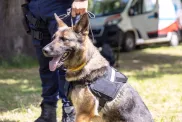By Dr. Shawn Messonnier
Like many of you, I try to enjoy as much physical activity as possible. Whether it’s lifting weights, jogging, swimming, doing yoga, or trying to squeeze in a round of golf, I love staying physically active. Unfortunately, my 46-year-old body can’t always keep up with my 20-year-old mind. As a result, I often find myself developing muscle soreness after some of my activities. Thankfully, a great massage loosens me up and leaves me ready to go back out and torture myself again!
Since massage works so well for people, can this form of alternative therapy be helpful for our canine family members? Absolutely! Massage is a great form of therapy for pets with any sort of musculoskeletal problems, and a gentle massage can be both enjoyable and relaxing. Plus, it’s a nice way to strengthen the owner-animal bond while helping to revitalize the pet.
How massage therapy works
Many pets suffer from a variety of musculoskeletal problems, including sprains, strains, torn ligaments, and arthritis — a common problem for older dogs. Massage can benefit pets suffering from any of those maladies. In addition to enhancing pets’ mobility by relaxing tight muscles, ligaments, and tendons, massage can also relieve pain that comes from inflamed tissues. It works by improving blood flow to the inflamed tissue, bringing oxygen into the damaged tissue, bringing white blood cells to help fight inflammation, and removing the toxins that occur as a result of inflammation and tissue damage.
As is true with people, injured dogs may have trigger points — or knots — in their muscles. Very gently massaging these trigger points can loosen the knotted muscle and restore it to its normal shape and function.
Part of physical therapy
Anyone can learn massage therapy for pets, but if you prefer to leave it to the professionals, you can choose from one of the many physical therapy centers for pets popping up all across the country. These physical therapy centers are most commonly associated with surgery centers.
Though often neglected in pets, physical therapy is fast becoming an important adjunct in the treatment of injured pets and in the postoperative recovery of pets who have had surgery for musculoskeletal problems. Physical therapy, including massage, can reduce the recovery time for pets with injuries and those who have had musculoskeletal skeletal surgery. And the nice part is that after the initial visit to the massage therapist or physical therapist, owners can easily be shown several exercises or massages they can do at home with their pet.
Even for pets without musculoskeletal injuries, a weekly gentle relaxing massage is enjoyed by most pets. Spending ten to twenty minutes per week is a great way to bond with your pet, as well as keep him pain-free and ready for your next shared activity.









